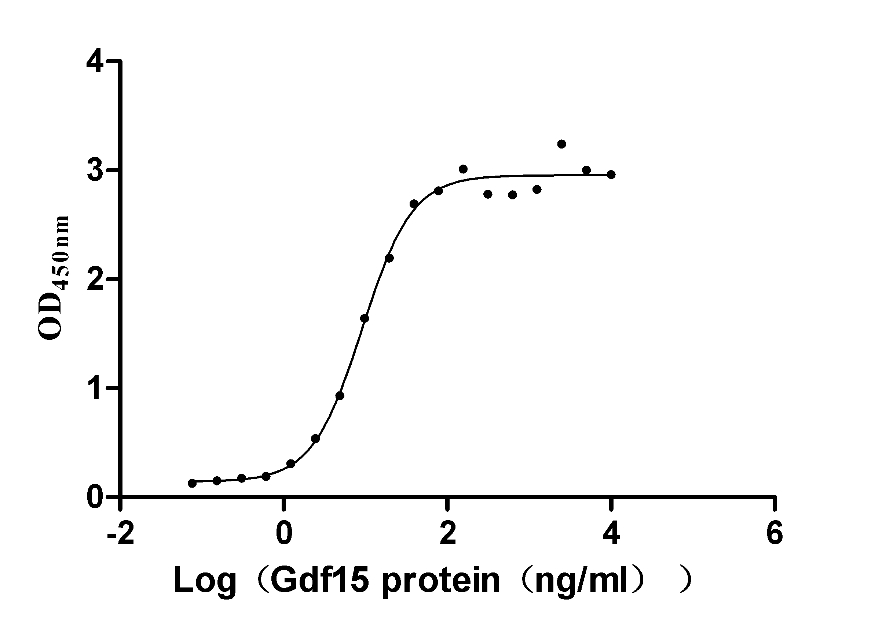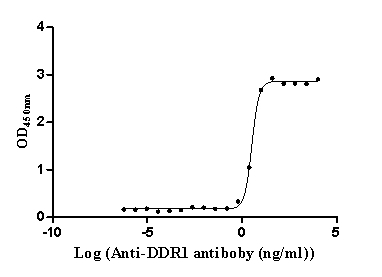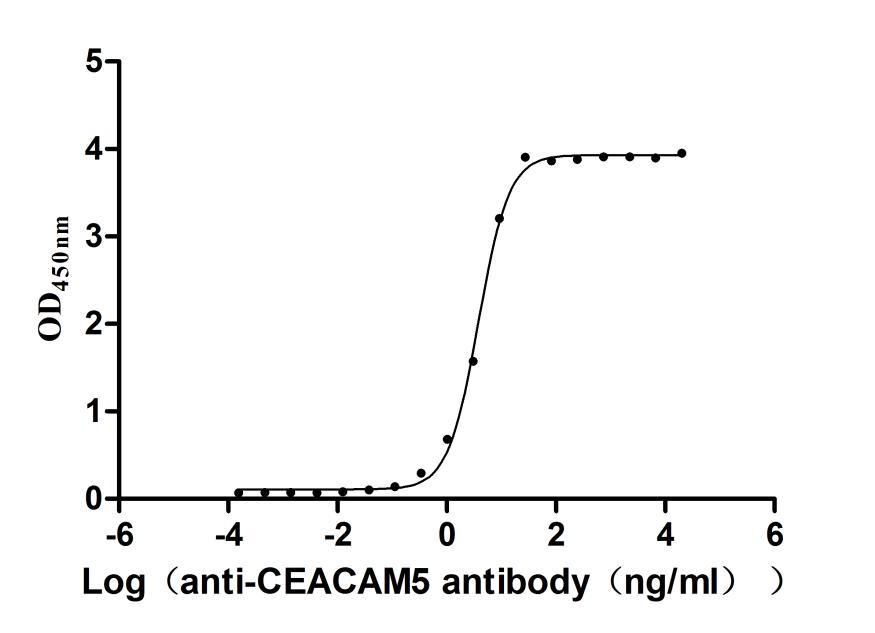Recombinant Mouse Plasminogen (Plg)
-
货号:CSB-YP018188MO
-
规格:
-
来源:Yeast
-
其他:
-
货号:CSB-EP018188MO
-
规格:
-
来源:E.coli
-
其他:
-
货号:CSB-EP018188MO-B
-
规格:
-
来源:E.coli
-
共轭:Avi-tag Biotinylated
E. coli biotin ligase (BirA) is highly specific in covalently attaching biotin to the 15 amino acid AviTag peptide. This recombinant protein was biotinylated in vivo by AviTag-BirA technology, which method is BriA catalyzes amide linkage between the biotin and the specific lysine of the AviTag.
-
其他:
-
货号:CSB-BP018188MO
-
规格:
-
来源:Baculovirus
-
其他:
-
货号:CSB-MP018188MO
-
规格:
-
来源:Mammalian cell
-
其他:
产品详情
-
纯度:>85% (SDS-PAGE)
-
基因名:
-
Uniprot No.:
-
别名:Plg; Plasminogen; EC 3.4.21.7) [Cleaved into: Plasmin heavy chain A; Activation peptide; Angiostatin; Plasmin heavy chain A; short form; Plasmin light chain B]
-
种属:Mus musculus (Mouse)
-
蛋白长度:Full Length of Mature Protein
-
表达区域:20-812
-
氨基酸序列D SLDGYISTQG ASLFSLTKKQ LAAGGVSDCL AKCEGETDFV CRSFQYHSKE QQCVIMAENS KTSSIIRMRD VILFEKRVYL SECKTGIGNG YRGTMSRTKS GVACQKWGAT FPHVPNYSPS THPNEGLEEN YCRNPDNDEQ GPWCYTTDPD KRYDYCNIPE CEEECMYCSG EKYEGKISKT MSGLDCQAWD SQSPHAHGYI PAKFPSKNLK MNYCRNPDGE PRPWCFTTDP TKRWEYCDIP RCTTPPPPPS PTYQCLKGRG ENYRGTVSVT VSGKTCQRWS EQTPHRHNRT PENFPCKNLE ENYCRNPDGE TAPWCYTTDS QLRWEYCEIP SCESSASPDQ SDSSVPPEEQ TPVVQECYQS DGQSYRGTSS TTITGKKCQS WAAMFPHRHS KTPENFPDAG LEMNYCRNPD GDKGPWCYTT DPSVRWEYCN LKRCSETGGS VVELPTVSQE PSGPSDSETD CMYGNGKDYR GKTAVTAAGT PCQGWAAQEP HRHSIFTPQT NPRAGLEKNY CRNPDGDVNG PWCYTTNPRK LYDYCDIPLC ASASSFECGK PQVEPKKCPG RVVGGCVANP HSWPWQISLR TRFTGQHFCG GTLIAPEWVL TAAHCLEKSS RPEFYKVILG AHEEYIRGLD VQEISVAKLI LEPNNRDIAL LKLSRPATIT DKVIPACLPS PNYMVADRTI CYITGWGETQ GTFGAGRLKE AQLPVIENKV CNRVEYLNNR VKSTELCAGQ LAGGVDSCQG DSGGPLVCFE KDKYILQGVT SWGLGCARPN KPGVYVRVSR FVDWIEREMR NN
-
蛋白标签:Tag type will be determined during the manufacturing process.
The tag type will be determined during production process. If you have specified tag type, please tell us and we will develop the specified tag preferentially. -
产品提供形式:Lyophilized powder
Note: We will preferentially ship the format that we have in stock, however, if you have any special requirement for the format, please remark your requirement when placing the order, we will prepare according to your demand. -
复溶:We recommend that this vial be briefly centrifuged prior to opening to bring the contents to the bottom. Please reconstitute protein in deionized sterile water to a concentration of 0.1-1.0 mg/mL.We recommend to add 5-50% of glycerol (final concentration) and aliquot for long-term storage at -20℃/-80℃. Our default final concentration of glycerol is 50%. Customers could use it as reference.
-
储存条件:Store at -20°C/-80°C upon receipt, aliquoting is necessary for mutiple use. Avoid repeated freeze-thaw cycles.
-
保质期:The shelf life is related to many factors, storage state, buffer ingredients, storage temperature and the stability of the protein itself.
Generally, the shelf life of liquid form is 6 months at -20°C/-80°C. The shelf life of lyophilized form is 12 months at -20°C/-80°C. -
货期:Delivery time may differ from different purchasing way or location, please kindly consult your local distributors for specific delivery time.Note: All of our proteins are default shipped with normal blue ice packs, if you request to ship with dry ice, please communicate with us in advance and extra fees will be charged.
-
注意事项:Repeated freezing and thawing is not recommended. Store working aliquots at 4°C for up to one week.
-
Datasheet :Please contact us to get it.
相关产品
靶点详情
-
功能:Plasmin dissolves the fibrin of blood clots and acts as a proteolytic factor in a variety of other processes including embryonic development, tissue remodeling, tumor invasion, and inflammation. In ovulation, weakens the walls of the Graafian follicle. It activates the urokinase-type plasminogen activator, collagenases and several complement zymogens, such as C1 and C5. Cleavage of fibronectin and laminin leads to cell detachment and apoptosis. Also cleaves fibrin, thrombospondin and von Willebrand factor. Its role in tissue remodeling and tumor invasion may be modulated by CSPG4. Binds to cells.; Angiostatin is an angiogenesis inhibitor that blocks neovascularization and growth of experimental primary and metastatic tumors in vivo.
-
基因功能参考文献:
- These studies suggest a crucial role for peripheral PL in mediating neuroimmune cell activation and Alzheimer's disease (AD) progression and could provide a link to systemic inflammatory risk factors that are known to be associated with AD development. PMID: 30254165
- Variation in blood plasminogen levels, within the range seen in normal individuals, had marked effects on experimental ischemic brain injury PMID: 27319402
- plasmin protease activity prevents dystrophic calcification within injured skeletal muscle independent of its canonical fibrinolytic function. PMID: 27530373
- Plasminogen-deficient mice have extensive fibrin and neutrophil depositions in the wounded area long after re-epithelialisation, indicating inefficient debridement and chronic inflammation. Delayed formation of granulation tissue suggests that fibroblast function is impaired in the absence of plasminogen. PMID: 26791370
- findings identify plasmin as a decisive checkpoint in the inflammatory response during Macrophage activation syndrome (MAS) and a potential novel therapeutic target for MAS. PMID: 28325863
- Deficiency of plasminogen delays onset of autoimmune neuroinflammatory disease and protects from the development of paralysis. PMID: 28275164
- Plasminogen may regulate DPP-4 activity and glucose metabolism. PMID: 27592166
- Plasminogen-deficient mice frequently develop colon lesions and rectal prolapses. PMID: 26473342
- manganese transport protein C (MntC) is an extracellular matrix- and plasminogen-binding protein PMID: 25409527
- Plg from mouse plasma contains oxPtdPC adducts that are not affected by the action of Lp-PLA(2), suggesting that linkage to Plg protects oxPtdPCs from metabolism during their transport in the plasma. PMID: 21614211
- plasminogen-dependent proteolysis has a beneficial effect during neurological recovery after stroke. PMID: 24732409
- Pla-induced mononuclear cell recruitment in vivo was dependent on protease-activated receptor-1 activation of the MEK/ERK/NF-kappaB pathway, which led to the release of CCL2 and activation of CCR2. PMID: 25165151
- Plg may play an important role in innate immunity by changing expression of genes that contribute to phagocytosis. PMID: 24876560
- Plasminogen is a key molecular determinant of inflammatory joint disease capable of simultaneously driving or ameliorating arthritis pathogenesis in distinct anatomic locations in the same subject. PMID: 24574269
- Plasmin suppresses brain metastasis in two ways: by converting membrane-bound astrocytic FasL into a paracrine death signal for cancer cells, and by inactivating the axon pathfinding molecule L1CAM, which metastatic cells express for spreading along brain capillaries and for metastatic outgrowth. PMID: 24581498
- Plasminogen stimulates autocrine cytokine production in human airway smooth muscle cells in a manner mediated by plasmin and annexin A2. PMID: 23721211
- plasminogen contributes to angiogenesis related to macrophage accumulation, TGF-beta, and VEGF, thereby leading to the enhancement of bone repair. PMID: 23456978
- These findings highlight a critical role for plasmin in the catabolism of aggregated LDL by macrophages and provide a new context for considering the atherogenic role of plasmin. PMID: 23702659
- Gender affects skin wound healing in plasminogen deficient mice. PMID: 23527289
- The increased plasmin generation during the early stages of sepsis could cleave/inactivate TFPI and thus lead to thrombotic complications. PMID: 23106863
- Macrophage gene expression and foam cell formation are regulated by plasminogen. PMID: 23401155
- These results demonstrate the novel requirement of a-enolase for restoring homeostasis of injured muscle tissue, by controlling the pericellular localization of plasmin activity. PMID: 23239981
- In summary, these data indicate that plasmin-driven fibrinolysis facilitates tumor growth by maintaining patency of the tumor vasculature. PMID: 22815383
- Plasmin is essential in preventing periodontitis in mice PMID: 21704601
- found that male Plg knockout mice, but not their female counterparts, exhibited normochromic normocytic anemia PMID: 22056679
- Dengue virus (DENV)-immunized mouse sera demonstrates antibody binding to both DENV and Plg when compared with nonimmune control mouse serum. PMID: 22079981
- Plasmin plays an essential role in amplification of psoriasiform skin inflammation. PMID: 21311769
- in endothelial cells, plasmin specifically induces activation of conventional PKC, which phosphorylates serine 11 and serine 25 of A2, triggering dissociation of the (A2.p11)(2) tetramer. PMID: 21115493
- Plasminogen is highly expressed in specific populations of hippocampal, cortical, and hypothalamic neurons, and plasminogen-containing vesicles are mainly observed at neuronal somata. PMID: 21190118
- Plasminogen/plasmin modulates bone metabolism by regulating the osteoblast and osteoclast function. PMID: 21239499
- analysis of the generation and characterization of mice expressing a plasmin-inactivating active site mutation PMID: 20653841
- Data show that upon binding of plasminogen to neurons, plasmin formed by constitutively expressed tissue plasminogen activator degrades extracellular matrix proteins, leading to retraction of the neuron monolayer that detaches from the matrix. PMID: 19683575
- The role of Plg and alpha2-AP in vascular thrombolysis was studied in mice lacking Plg or a2-AP. Lack of Plg reduces the antithrombotic activities in vivo, but alpha2-AP plays a more important role in the formation/removal of venous thrombi. PMID: 11848464
- RT-PCR and In Situ Hybridization study of tissue distribution of Plg mRNA in adrenal, kidney, brain, testis, heart, lung, uterus, spleen, thymus and gut PMID: 11916082
- Plasmin activity is required for myogenesis in vitro and skeletal muscle regeneration in vivo. PMID: 11929773
- important role in adipose tissue accumulation associated with growth and differentiation of stromal cells PMID: 12083480
- These results indicate the presence of regulatory elements in the 5'-flanking region of the murine plasminogen promoter that may regulate murine plasminogen gene expression and, hence, plasmin activity. PMID: 12149246
- Plg mRNA was undetectable in the normal brain, but after kainate injection it was induced in neuronal cells in multiple, but specific areas. This distribution pattern coincided with that of the plasminogen activator inhibitor-2 mRNA. PMID: 12225871
- role of pCPB as a modulator of the pivotal functions of plasminogen in fibrinolysis and cell migration in vivo. PMID: 12417566
- Significantly greater retention of PMNs within the thrombi of PG(-/-) mice provided potential for more PMN derived fibrinolytic enzymes and a relatively greater role for PMNs-initiated fibrinolysis and differently cleaved fibrinogen degradation products. PMID: 12428098
- plasminogen directs the hepatocyte injury induced by transgene-derived urokinase-type plasminogen activator and mediates the reparative properties of urokinase-type plasminogen activator in the liver PMID: 12431907
- plasminogen mRNA from hepatocyte is dependent on the cell density and the stimulation by cell-cell contact may be an important factor for the constitutive expression of plasminogen gene PMID: 12559391
- Results demonstrate that the combination of matrix metalloproteinases and plasminogen is essential for the proper development of the placenta. PMID: 12900459
- plasmin has a role as an intracellular protease PMID: 12928439
- When uPA and uPAR transgenic mice were backcrossed into a plasminogen-deficient (Plg-/-) background, the dental and skin phenotypes appeared completely normal. PMID: 15161662
- Corneal angiogenesis is dependent on Plg. PMID: 15166500
- Plasminogen is bound to the cell surface by histidine-rich glycoprotein PMID: 15220341
- Plasminogen exerts a marked influence on both neutrophil and monocyte/macrophage recruitment to implanted biomaterials. PMID: 15456492
- Plg/Pla stimulates c-fos and egr-1 expression via activation of the MEK/ERK pathway PMID: 15721299
- Our results suggest that plasmin-mediated cell detachment could contribute to the pathological effects of Abeta in diseased brain. PMID: 15737740
显示更多
收起更多
-
亚细胞定位:Secreted.
-
蛋白家族:Peptidase S1 family, Plasminogen subfamily
-
数据库链接:
KEGG: mmu:18815
STRING: 10090.ENSMUSP00000014578
UniGene: Mm.971
Most popular with customers
-
Recombinant Human Neural cell adhesion molecule L1 (L1CAM), partial (Active)
Express system: Mammalian cell
Species: Homo sapiens (Human)
-
Recombinant Mouse GDNF family receptor alpha-like (Gfral), partial (Active)
Express system: Mammalian cell
Species: Mus musculus (Mouse)
-
Recombinant Human Intestinal-type alkaline phosphatase (ALPI) (Active)
Express system: Mammalian cell
Species: Homo sapiens (Human)
-
Recombinant Human Epithelial discoidin domain-containing receptor 1 (DDR1), partial (Active)
Express system: Mammalian cell
Species: Homo sapiens (Human)
-
Recombinant Human Early activation antigen CD69 (CD69), partial (Active)
Express system: Mammalian cell
Species: Homo sapiens (Human)
-
Recombinant Macaca fascicularis C-type lectin domain family 4 member C(CLEC4C), partial (Active)
Express system: Mammalian cell
Species: Macaca fascicularis (Crab-eating macaque) (Cynomolgus monkey)
-
Recombinant Human Transmembrane 4 L6 family member 1(TM4SF1)-VLPs (Active)
Express system: Mammalian cell
Species: Homo sapiens (Human)
-
Express system: Mammalian cell
Species: Macaca mulatta (Rhesus macaque)




















